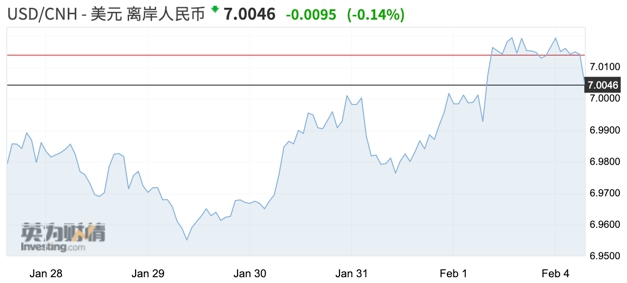The appreciation of the RMB since the beginning of this year was interrupted by a sudden epidemic.
The time goes back to before the Spring Festival. As of midday on January 20, Beijing time, USD/CNY was at 6.8477, and USD/OCR was at 6.8521. In September 2019, the U.S. dollar was close to 7.19 against the yuan. In less than half a year, the RMB has appreciated by more than 4% against the US dollar.
This wave of appreciation was interrupted by the sudden epidemic.
On February 3, the central bank announced that the central parity rate of RMB against the US dollar was lowered by 373 points to 6.9249 from the previous day. The central parity rate depreciated to the lowest level since January 13, 2020, and the decline was the highest since August 6, 2019. The largest ever. The onshore RMB closed down 957 basis points at 7.0257 against the US dollar at 16:30, hitting a new low since December 12 last year. In fact, in the past few days, the offshore RMB exchange rate has hit the “7” mark many times.

The central parity rate of RMB exchange rate in the inter-bank foreign exchange market on February 4, 2020 was: 1 US dollar to RMB 6.9779.
Predictions from all parties: How will the exchange rate go? This is one of the issues that everyone is most concerned about.
The market generally believes that the impact of the epidemic on the RMB is phased, and it is still China’s economic fundamentals that determine the mid- to long-term trend of the RMB.
Guan Tao, who once served as deputy director and director of the Balance of Payments Department of the State Administration of Foreign Exchange, recently wrote an article stating that it is expected that the new coronavirus epidemic will have a temporary impact on the RMB exchange rate in the future. With the arrival of the concentrated outbreak period and its substantial economic impact, the RMB exchange rate will come under periodic pressure. However, as the epidemic subsides, the impact subsides, and the pressure gradually subsides, the RMB exchange rate will return to a two-way fluctuation trend. Fundamental factors will determine whether the RMB will appreciate or depreciate externally.
Li Liuyang, chief foreign exchange analyst at China Merchants Bank, predicts that the response of the RMB exchange rate to the epidemic will be short-term and long-term. However, the RMB’s decline is expected to be limited, after all, the epidemic will not change the long-term economic trend.
Xie Yaxuan, chief macro analyst of China Merchants Securities, said that when the situation is not yet clear, the financial market is prone to a certain degree of panic, which can lead to overshooting of asset prices. He believes that investors should view short-term fluctuations in the RMB exchange rate rationally:
First, the uncertainty of the epidemic has been reflected in the current trend of the RMB exchange rate to a certain extent. In order to make a more accurate assessment, we should at least observe whether there are significant changes in the relevant data before and after February 8.
Second, the market gradually plays a decisive role in the formation of the RMB exchange rate, and investors should be more adaptable to exchange rate fluctuations within 2% within a day.
Thirdly, since 2017, the onshore RMB exchange rate has fluctuated in both directions within the range of 6.2370-7.1962. In this process, there are many factors affecting the RMB exchange rate, and the current epidemic is likely to be only a short-term impact. There is no need to panic based on this short-term factor.
Industrial Research’s macro team said that the RMB exchange rate is still under pressure and the market should be wary of stock-exchange linkage. If the epidemic situation slows down in mid-to-late February, the RMB may experience a phased rebound after overshooting.
In the latest China Economic Insights published by UBS on February 3, it maintained its forecast that the RMB exchange rate against the U.S. dollar would be 7 by the end of 2020. “Slowing economic growth and other factors have put pressure on the RMB exchange rate. , but China’s commitment to keeping the RMB exchange rate stable and the expected improvement in current account surplus should provide certain support for the exchange rate.”
At the same time, UBS analysis believes that the impact on consumption will be greater than that on investment and trade: consumption is expected to It has been significantly affected, especially travel, accommodation and catering, transportation, etc. It is expected that the overall retail sales growth of consumer goods may slow down by at least 5 percentage points in the first quarter. The impact on overall fixed asset investment and real estate activities should be smaller than consumption, but still greater than during the SARS period. Although economic activity is usually relatively flat in January and February, more areas have implemented traffic restrictions and delayed business resumption during the epidemic than during SARS, which can delay or weaken some industrial production and export activities.
In addition, UBS believes that it is very difficult to assess the impact of the epidemic on the economy at this stage. If the epidemic is controlled in the first quarter and there are basically no new cases thereafter, it is expected that the GDP growth rate in the first quarter may slow down to 3.8% year-on-year. After that, as economic activities return to normal and previously suppressed demand is released, Coupled with policy support, economic growth is expected to rebound in the second to fourth quarters. Under this circumstance, the GDP growth forecast for 2020 is lowered to 5.4%. Risks to our baseline forecast are tilted to the downside. If the peak of the epidemic continues into the second quarter, GDP growth in 2020 may drop below 5%.
As the external environment is still unclear, it is recommended that everyone keep paying attention to exchange rate fluctuations even during the vacation!
</p






